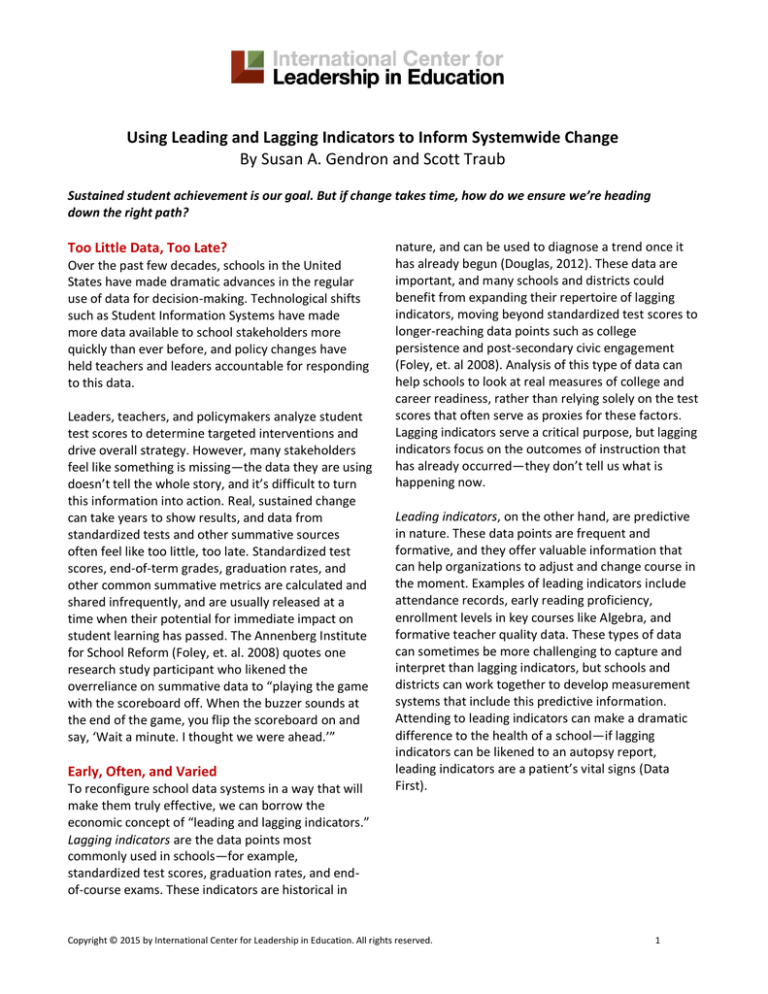Using Leading and Lagging Indicators to Inform
advertisement

Using Leading and Lagging Indicators to Inform Systemwide Change By Susan A. Gendron and Scott Traub Sustained student achievement is our goal. But if change takes time, how do we ensure we’re heading down the right path? Too Little Data, Too Late? Over the past few decades, schools in the United States have made dramatic advances in the regular use of data for decision-making. Technological shifts such as Student Information Systems have made more data available to school stakeholders more quickly than ever before, and policy changes have held teachers and leaders accountable for responding to this data. Leaders, teachers, and policymakers analyze student test scores to determine targeted interventions and drive overall strategy. However, many stakeholders feel like something is missing—the data they are using doesn’t tell the whole story, and it’s difficult to turn this information into action. Real, sustained change can take years to show results, and data from standardized tests and other summative sources often feel like too little, too late. Standardized test scores, end-of-term grades, graduation rates, and other common summative metrics are calculated and shared infrequently, and are usually released at a time when their potential for immediate impact on student learning has passed. The Annenberg Institute for School Reform (Foley, et. al. 2008) quotes one research study participant who likened the overreliance on summative data to “playing the game with the scoreboard off. When the buzzer sounds at the end of the game, you flip the scoreboard on and say, ‘Wait a minute. I thought we were ahead.’” Early, Often, and Varied To reconfigure school data systems in a way that will make them truly effective, we can borrow the economic concept of “leading and lagging indicators.” Lagging indicators are the data points most commonly used in schools—for example, standardized test scores, graduation rates, and endof-course exams. These indicators are historical in nature, and can be used to diagnose a trend once it has already begun (Douglas, 2012). These data are important, and many schools and districts could benefit from expanding their repertoire of lagging indicators, moving beyond standardized test scores to longer-reaching data points such as college persistence and post-secondary civic engagement (Foley, et. al 2008). Analysis of this type of data can help schools to look at real measures of college and career readiness, rather than relying solely on the test scores that often serve as proxies for these factors. Lagging indicators serve a critical purpose, but lagging indicators focus on the outcomes of instruction that has already occurred—they don’t tell us what is happening now. Leading indicators, on the other hand, are predictive in nature. These data points are frequent and formative, and they offer valuable information that can help organizations to adjust and change course in the moment. Examples of leading indicators include attendance records, early reading proficiency, enrollment levels in key courses like Algebra, and formative teacher quality data. These types of data can sometimes be more challenging to capture and interpret than lagging indicators, but schools and districts can work together to develop measurement systems that include this predictive information. Attending to leading indicators can make a dramatic difference to the health of a school—if lagging indicators can be likened to an autopsy report, leading indicators are a patient’s vital signs (Data First). Copyright © 2015 by International Center for Leadership in Education. All rights reserved. 1 Cultivating Confidence Change takes time. The learning curve associated with the implementation of reforms and new initiatives can be challenging and uncomfortable. Michael Fullan (2007) describes the “implementation dip” that often occurs during the change process. He explains, “the implementation dip is literally a dip in performance and confidence as one encounters an innovation that requires new skills and new understandings.” This dip can be made bearable by acknowledging and celebrating small successes along the way. Leading indicators can provide early and often evidence of these successes, increasing stakeholder confidence. For example, if a new instructional method is increasing student engagement, attendance levels (a leading indicator) will increase before this increased engagement manifests in standardized test scores (a lagging indicator). On the other hand, leading indicators can provide an early warning when an intervention is NOT having the intended impact, allowing teachers and leaders to make relevant adjustments and change course as needed. Designing a Comprehensive Data System Many schools, districts, and even states are now designing data systems that incorporate the measurement and analysis of both leading and lagging indicators. For example, in the state of Mississippi, the Department of Education has developed a school transformation plan that tracks leading indicators, including discipline incidents and teacher attendance rate, alongside lagging indicators, such as proficiency on state assessments and college enrollment rates (Mississippi DOE, 2012). The following guidelines can help you incorporate leading and lagging indicators into your planning: Carefully define the leading and lagging indicators that are most relevant to your environment. Since every school and community has its own DNA, consider the data points that are meaningful for your stakeholders. The Annenberg study defines leading indicators as indicators that are timely and actionable, benchmarked, and powerful. (p. 3) Gather, analyze, and use data at the individual student level AND the systemic level. Leading and lagging indicators can inform decisions and interventions at the micro- and macro-levels. Having short-term and long-term data on individual students can help to guide each student’s instructional pathway and identify strengths and challenges. The same types of data used at an institutional level can drive new innovations and systemic reforms. Make data analysis part of the culture at your school. Empowering every staff member at your school to access and analyze data can have a dramatic impact on teacher practice and student learning. Consider making deep data dives a regular part of your professional learning community work, and incorporate leading and lagging indicators into these discussions. Seeing the Whole Picture In order to make lasting and meaningful change in schools, we need to understand the long-term, historical trends in our work, but we also need to adapt, stay agile, and respond to what we see in the moment. Creating and refining comprehensive data processes that involve the thoughtful collection and analysis of data about both leading and lagging indicators can help us to walk this line. Each data source is one piece of the school improvement puzzle—let’s make sure we’re looking at the whole picture when we make decisions about teaching and learning. References Data First: Leading and Lagging Indicators. [Video file.] Retrieved from http://www.datafirst.org/learning/leading-and-laggingindicators/ Douglas, E. (2012, Aug 14) Leading and lagging: Balancing education measures. Education Week. [Blog post] Retrieved from http://blogs.edweek.org/topschooljobs/k12_talent_manager/2012/08/leading_lagging _balancing_measures.html Copyright © 2015 by International Center for Leadership in Education. All rights reserved. 2 Foley, E., Mishook, J., Thompson, J., Kubiak, M., Supovitz, J., and Rhude-Faust, M.K. (2008) Beyond test scores: Leading indicators for education. Annenberg Institute for School Reform. Retrieved from http://annenberginstitute.org/sites/default/fi les/product/206/files/LeadingIndicators.pdf Fullan, M., (2007) Leading in a culture of change. New York: Jossey-Bass. Leading and Lagging Indicators, Mississippi Department of Education. (2012) Retrieved February 19, 2015 from http://home.mde.k12.ms.us/OSR/LLI About the Authors Susan A. Gendron is President of the International Center for Leadership in Education; Scott Traub is the Executive Director of Education Partnerships, West. Copyright © 2015 by International Center for Leadership in Education. All rights reserved. 3

